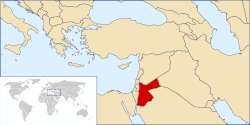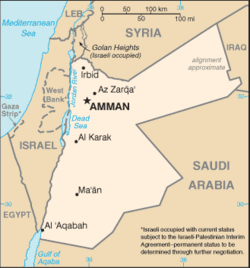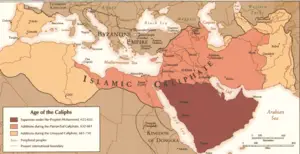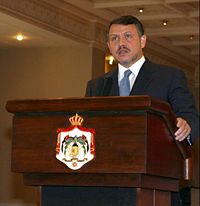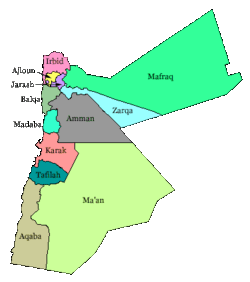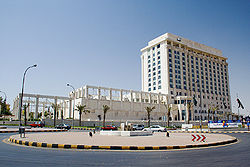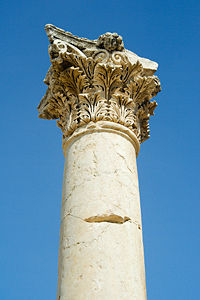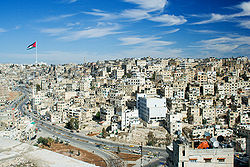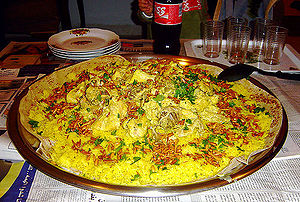Difference between revisions of "Jordan" - New World Encyclopedia
Mike Butler (talk | contribs) |
Mike Butler (talk | contribs) (→Music) |
||
| Line 180: | Line 180: | ||
Legislative power rests in the bicameral National Assembly. The 110-member Chamber of Deputies, elected by universal suffrage ("one person, one vote"), to a four-year term, is subject to dissolution by the king. Nine seats are reserved for Christians, six for women, and three for [[Circassians]] and [[Chechens]]. The 40-member [[Senate]] is appointed by the king for a four-year term. | Legislative power rests in the bicameral National Assembly. The 110-member Chamber of Deputies, elected by universal suffrage ("one person, one vote"), to a four-year term, is subject to dissolution by the king. Nine seats are reserved for Christians, six for women, and three for [[Circassians]] and [[Chechens]]. The 40-member [[Senate]] is appointed by the king for a four-year term. | ||
| − | The constitution provides for three categories of courts: civil, religious, and special. Jordan's legal system is based on [[Islamic]] law and [[French]] codes. Judicial review of legislative acts occurs in a special High Tribunal. It has not accepted compulsory [[International Court of Justice]] jurisdiction. Jordan has a low crime rate, with few petty crimes. Under the Islamic system, honor killings, such as if a woman | + | The constitution provides for three categories of courts: civil, religious, and special. Jordan's legal system is based on [[Islamic]] law and [[French]] codes. Judicial review of legislative acts occurs in a special High Tribunal. It has not accepted compulsory [[International Court of Justice]] jurisdiction. Jordan has a low crime rate, with few petty crimes. Under the Islamic system, honor killings, such as if a woman family member’s chastity is compromised, may lead to a light sentence or charges being dropped. Jordan uses the death penalty, and allegedly torture. |
Administratively, Jordan is divided into 12 [[governor]]ates, each headed by a governor appointed by the king. They are the sole authorities for all government departments and development projects in their respective areas. | Administratively, Jordan is divided into 12 [[governor]]ates, each headed by a governor appointed by the king. They are the sole authorities for all government departments and development projects in their respective areas. | ||
| Line 270: | Line 270: | ||
==Culture== | ==Culture== | ||
[[Image:Amman.jpg|thumb|250px|right|A view from Jabal al-Qal'a, the historical centre of Amman.]] | [[Image:Amman.jpg|thumb|250px|right|A view from Jabal al-Qal'a, the historical centre of Amman.]] | ||
| + | The culture of [[Jordan]] is based on [[Arab]] and [[Islam|Islamic]] elements. The government promotes cultural festivals, encourages the revival of handicrafts, and takes steps to preserve the country's archaeological and historical heritage. Folk art survives in tapestries, leather crafts, pottery, and ceramics. Wool and goat hair rugs with colorful tribal designs are manufactured. Notable aspects of the culture include the music of Jordan as well as an interest in sports, particularly [[football]] (soccer) and [[basketball]] as well as other imported sports mainly from the west and other elements. They also have camel races. | ||
| + | |||
| + | ===Architecture=== | ||
| + | Most people live in one- or two-room apartments or houses. Affluent urban families have larger apartments or separate homes. Buildings are mostly made of concrete, to which more floors may be added, to create apartments for married sons. Many homes open into private courtyards with concrete walls. Amman's appearance reflects a Western in. | ||
| + | |||
| + | ===Food=== | ||
| + | Essential to any cooking in the Arabian Peninsula is the concept of hospitality. Meals are generally large family affairs, with much sharing and a great deal of warmth over the dinnertable. Formal dinners and celebrations generally entail large quantities of lamb, and every occasion entails large quantities of tea. | ||
| + | |||
| + | A feta-like cheese is called halloumi, made from goat or sheep milk , is served in a sandwich of pita-style bread or cubed in salads. Rice, legumes, olives, yogurt, flat breads, vegetables including cauliflower, eggplant, potatoes, okra, tomatoes, and cucumbers, lamb or chicken, and fruits (apricots, apples, bananas, melons, and oranges) form the basis for most meals. | ||
| + | [[Image:Mansaf1.jpg|right|thumb|300px|A homecooked Mansaf, [[Amman]], [[Jordan]]]] | ||
| + | The national main dish is Mansaf, which is lamb cooked in dried yogurt and served with seasoned rice on flat bread. The main meal is served during the middle of the afternoon. A covering is placed on the floor. A dinner may consist of a very large platter, shared commonly, with a vast mountain of rice, incorporating lamb or chicken, or both, as separate dishes, with various stewed vegetables, heavily spiced, sometimes with a [[tomato sauce]]. Most likely, there would be several other items on the side, less hearty. Tea would certainly accompany the meal, as it is almost constantly consumed. [[Coffee]] would be included. Torn pieces of bread are folded in half and used to scoop the food. The left hand is never used to feed oneself. | ||
| + | |||
| + | [[Cinnamon]] is used in meat dishes as well as in sweets such as [[baklava]]. Other desserts include variations of [[rice pudding]] and [[fried dough]]. Ground [[nut (fruit)|nut]] mixtures are common fillings for such treats. [[Saffron]] is used in everything, from sweets, to rice, to beverages. [[Fruit juice]]s are quite popular in this often arid region. | ||
| + | |||
| + | ===Etiquette=== | ||
| + | Greetings and farewells are lengthy and sincere. Visitors are invited for dinner, where they are showered with kindness and food. Women dress modestly and are offended by exposed flesh. Shoes are removed before entering a mosque, and a homel. Feet are never put on a coffee table, footstool, or desk. Same-sex friends hold hands, hug, and kiss in public. There is limited touching between men and women. | ||
| + | |||
| + | ===Literature=== | ||
| + | Jordan’s most famous poet is Mustafa Wahbi al-Tal, who is among the major Arab poets of the twentieth century. Al-Tal was a political and social activist who devoted 20 years of his life to regaining the rights of gypsies and became a member of the gypsy community. | ||
| + | |||
| + | ===Music=== | ||
| + | [[Image: Bilocate_2006_Dysphoria_Promo.jpg|right|thumb|300px|Jordanian doom/death metal band Bilocate.]] | ||
| + | The music of Jordan can be distinguished from that of [[Syria]] and [[Saudi Arabia]] by its strong [[Bedouin]] influence. Rural [[zajal]] songs, with improvised poetry played with a [[rabab]], a stringed lute-type instrument, and [[reed pipe]] ensemble accompanying is popular. Villagers have special songs for births, weddings, funerals, planting, ploughing, and harvesting. | ||
| + | |||
| + | The Bedouin singer [[Omar Al-Abdillat]] and [[Diana Karazon]], winner of the Arab version of [[Pop Idol]], are perhaps Jordan's biggest stars, known for his patriotic song "Hashemi, Hashemi". Other well-known Jordanian musicians are [[Qamar Badwan]], who won the golden prize in the 2000 [[Cairo Song Festival]], [[percussionist]] [[Hani Naser]], the [[piano|pianist]], and [[composer]] [[Khalid Asad]]. A new age group called Rum, lead by Tareq Al Nasser has been gaining regional and international popularity. | ||
| + | |||
| + | In [[Amman]], there has been a movement of alternative music in the last two decades. Rock bands that mix western and eastern influences are continuously becoming more popular, examples of which are Ethereal, which was famous early this decade, Signs of Thyme among many others, and Illusions who are famous for their pure classic rock style. Jordan is also known to have quite a big underground heavy metal scene, with many bands reaching international audiences such as Augury, Ajdath, [[Bilocate]], Darkcide, and others. | ||
| + | |||
| + | ===Sports=== | ||
| + | Football is the most-played game in Jordan. Football became increasingly popular in Jordan, especially because of improvements in Jordan's National Football Team FIFA results. The National Basketball Team is now being sponsored by [[Fastlink]] and participating in various Arab and Middle East Basketball competitions. | ||
| + | |||
| + | Televised professional competition boosted the popularity of darts. The Jordanian head of state, [[Abdullah II]], is even said to be a fan. Young professional Ramzi "The Jordanian Dragon" Qattan, who, at 22 years old, averages an impressive 102.8. Indeed, Qattan comes from a family of great sportsmen: his cousin currently represents Jordan at international rugby, and his father was a star of the Jordanian [[handball]] team that found fame in the late 70s. | ||
==Notes and references== | ==Notes and references== | ||
Revision as of 07:17, 19 May 2007
| المملكة الأردنية الهاشمية Al-Mamlakah al-Urdunniyyah al-Hāšimiyyah Hashemite Kingdom of Jordan | |||||
| |||||
| Anthem: عاش المليك As-salam al-malaki al-urdoni (transliteration)1 Long live the King | |||||
| Capital | Amman 31°57′N 35°56′E | ||||
|---|---|---|---|---|---|
| Largest city | capital | ||||
| Official languages | Arabic | ||||
| Government | Constitutional monarchy | ||||
| - King | Abdullah II | ||||
| - Prime Minister | Marouf al-Bakhit | ||||
| Independence | |||||
| - End of British League of Nations mandate | 25 May 1946 | ||||
| Area | |||||
| - Total | 89,342 km² (112th) 45,495 sq mi | ||||
| - Water (%) | negligible | ||||
| Population | |||||
| - July 2005 estimate | 5,350,000 | ||||
| - 2003 census | 4,755,000 | ||||
| - Density | 64/km² 166/sq mi | ||||
| GDP (PPP) | 2005 estimate | ||||
| - Total | $27.96 billion | ||||
| - Per capita | $4,825 | ||||
| HDI (2004) | |||||
| Currency | Jordanian dinar (JOD)
| ||||
| Time zone | UTC+2 (UTC+2) | ||||
| - Summer (DST) | UTC+3 (UTC+3) | ||||
| Internet TLD | .jo | ||||
| Calling code | +962 | ||||
The Hashemite Kingdom of Jordan, commonly called Jordan, is an Arab country in the Middle East between the West Bank and Saudi Arabia. It shares with Israel the coastlines of the Gulf of Aqaba and the Dead Sea. Jordan's principal religion is Islam, and its main language is Arabic.
Jordan is one of the 15 cradle-of-civilization countries. Jordan has numerous ancient sights. Petra in Ma'an, the home of the Nabateans, is a complete city carved in a mountain. The River Jordan is where Jesus Christ was baptised, by John the Baptist. Mount Nebo, where Moses was said to have gone to get a view of the Promised Land before he died.
Geography
Jordan is bordered by Syria to the north, Iraq to the northeast, Saudi Arabia to the east and south and both Israel and the West Bank to the west. The Gulf of Aqaba and the Dead Sea also touch the country.
Jordan’s area at more than 45,495 square miles (90,000 km²), is close to that of Maine, in the United States.
Jordan consists mostly of an arid desert plateau in the east, with a highland area in the west. The Great Rift Valley of the Jordan River separates Jordan and Israel. The highest point in the country is Jabal Ram at 5689 feet (1734 meters), while the lowest is the Dead Sea at 1594 feet (486 meters) below sea level.
The climate in Jordan is dry and hot, since the country is mainly desert. The rainy season is from November to March. Most of the East Bank receives less than 47 inches (120 millimeters) of rain a year and may be classified as a dry desert or steppe region. In the highlands east of the Jordan Valley, precipitation increases to around 118 inches (300mm) in the south and 197 inches (500mm) or more in the north.
Daytime temperatures during the summer frequently exceed 96.8°F (36°C), while the winter months—November to April—bring moderately cool and sometimes cold weather, averaging about 55.4°F (13 °C). Except in the rift depression, frost is common during the winter, and snow falls at the higher elevations of the north western highlands. Usually it snows a couple of times in western Amman.
The Jordan River is short, but from its mountain headwaters — approximately 100 miles (160km) north of the river's mouth at the Dead Sea — the riverbed drops from an elevation of about 9842 feet (3000 meters) above sea level to more than 1312 feet (400 meters) below sea level. Before reaching Jordanian territory the river forms Lake Tiberias, the surface of which is 695 feet (212 meters) below sea level. The Jordan River's principal tributary is the Yarmuk River. Near the junction of the two rivers, the Yarmuk forms the boundary between Israel on the northwest, Syria on the northeast, and Jordan on the south. The Az Zarqa River, the second main tributary of the Jordan River, rises and empties entirely within the East Bank.
Environment issues include limited natural fresh water resources, deforestation, overgrazing, soil erosion, and desertification.
Jordan has numerous ancient sights. Petra in Ma'an, the home of the Nabateans, is a complete city carved in a mountain. The huge rocks are colorful, mostly pink, and the entrance to the ancient city is through a 1.25km narrow gorge in the mountain - called the Siq. In the city are various structures, all (except two) are carved into rock, including al Khazneh - known as the Treasury - which is now nominated by the New Seven Wonders organisation to be one of the New Seven Wonders of the World. Other major sites of interest in Petra include the Monastery, the Roman theatre, the Royal Tombs, the High Place of Sacrifice. Petra was rediscovered for the western world by Swiss explorer Johann Ludwig Burckhardt in 1812.
Umm Qais is a town located on the site of the ruined Roman city of Gadara. Ajlun is famous for the Islamic al-Rabadh Castle. Jerash is famous for its its ancient Roman architecture, including the colonnaded streets, arches, Roman theatres, and the Oval Plaza.
Amman has the Roman theater, in addition to several museums, where one may find remains of the Dead Sea Scrolls.
Al Karak contains an important castle from the times of Salah al-Din, known as Al-Karak Castle. Madaba is well known for its mosaics. The River Jordan is where Jesus Christ was baptised, by John the Baptist. Mount Nebo, where Moses was said to have gone to get a view of the Promised Land before he died.
The capital and largest city is Amman, named after the Ammonites, whose capital it was in the thirteenth century B.C.E. With a population of 2,125,400, it is a regional commercial center as well as an Arabic cultural capital. Other cities include Irbid and Az Zarqa, both in the north. Most of the populace, though, resides in or near the capital, Amman.
History
The land that became Jordan forms part of the richly historical Fertile Crescent region. Evidence of human settlement in Jordan dates back to the Paleolithic period (500,000 - 17000 B.C.E.). While there is no architectural evidence from this era, archaeologists have found tools, such as flint and basalt hand-axes, knives and scraping implements.
Throughout history, Jordan has been inhabited by several civilizations. The first civilization on record is during the Neolithic period, around 6500 B.C.E., when archaeological discoveries in Ain Ghazal, located in eastern Amman, showed evidence of not only a settled life but also the growth of artistic work, which suggests that a well-developed civilization inhabited the city at that time.
While in Egypt and Mesopotamia, writing developed before 3000 B.C.E., writing was not really used in Jordan, Palestine and Syria until some thousand years later, even though archeological evidence indicates that Jordan was in fact trading with Egypt and Mesopotamia.
Around the second half of the third millennium B.C.E., Semitic Amorites settled around the Jordan River in the area called Canaan and worshipped the god Amurru. From Mount Nebo in western Jordan, many people believe that Moses saw the Promised Land (c.1213 B.C.E.).

In the thirteenth century B.C.E., what later became the capital, Amman, was called Rabbath Ammon by the Ammonites.
The Edomites
“Edom” (Hebrew for "red") is a name given to Esau in the Hebrew Bible, as well as to the nation purportedly descended from him. The Edomite people were a Semitic-speaking tribal group inhabiting the Negev Desert and the Aravah valley of what is now southern Israel and adjacent Jordan. The nation of Edom is known to have existed back to the eighth or ninth century B.C.E., and the Bible and archaeological evidence dates it back several centuries further.
The Edomites are believed to be early inhabitants of Petra, an archaeological site in Jordan, lying in a large valley running from the Dead Sea to the Gulf of Aqaba. It is famous for having many stone structures carved into the rock. The long-hidden site was revealed to the Western world by the Swiss explorer Johann Ludwig Burckhardt in 1812.
Nabataean kingdom
The territory became part of the Nabataean kingdom, possibly around 312 B.C.E. The Nabataeans, whose origins remain obscure, were an ancient trading people of southern Jordan, Canaan and the northern part of Arabia- whose oasis settlements in the time of Josephus gave the name of Nabatene to the borderland between Syria and Arabia, from the Euphrates to the Red Sea. Their loosely-controlled trading network, which centered on strings of oases that they controlled, where agriculture was intensively practiced in limited areas, and on the routes that linked them, had no securely defined boundaries in the surrounding desert.
The Nabateans built the capital of their ancient Arab kingdom, Petra, in what is now Jordan between 400 B.C.E. and 160 C.E. The ability of the Nabateans to control the water supply that led to the rise of the desert city, in effect creating an artificial oasis. The area is visited by flash floods and archaeological evidence demonstrates the Nabateans controlled these floods by the use of dams, cisterns and water conduits. Thus, stored water could be employed even during prolonged periods of drought, and the city prospered from its sale.
The territory was later conquered by the Assyrians (c. 722 B.C.E.,), followed by the Persians (c. 597 B.C.E.). Alexander the Great conquered the area around 331 b.c.e.. Ptolemy II Philadelphus, the Hellenic ruler of Egypt, renamed the city of Rabbath Ammon “Philadelphia”.
Emperor Trajan conquered the Nabataeans and incorporated them into the Roman Empire in 106 C.E., where their individual culture, easily identified by their characteristic finely-potted painted ceramics, became dispersed and was eventually lost. Philadelphia came under Roman control and joined the Decapolis — a group of 10 cities on the eastern frontier of the Roman Empire in Syria and Judea that was renamed Palaestina in 135 C.E.
In 324 C.E., Christianity became the religion of the of the Byzantine empire, and Philadelphia became the seat of a bishopric. One of the churches of this period can be seen on the city's Citadel.
The Ghassanids
The Ghassanids were Arab Christians who emigrated in the year 250 from Yemen to the Hauran, in southern Syria, south of Damascus. The Ghassanid kingdom was an ally of the Byzantine Empire, although Ghassanid kings can be more accurately described as phylarchs, native rulers of subject frontier states.. The capital was at Jabiyah in the Golan Heights, and their rule covered much of Syria, Lebanon), Palestine, Jordan and the northern Hijaz as far south as Yathrib (Medina). The Ghassanids acted as guardians of trade routes, policed Bedouin tribes and was a source of troops for the Byzantine army. Their rule lasted until to 638 C.E. Philadelphia was renamed Amman during the Ghassanian era, and
Muslim era
Beginning in the seventh century C.E., Islam spread through the region. The territory flourished under the caliphates, with nearby capital of the Umayyad Muslims (636 C.E. – 750 C.E.) in Damascus, and the Abbasids (750 –950) in Baghdad. Islamic control continued under the Mameluks (1174 – 1517), and the Ottoman Turks (1517-1918).
Amman was destroyed by several earthquakes and natural disasters and remained a small village and a pile of ruins until the Circassians settlement in 1887.
When the Ottoman Sultan decided to build the Hejaz railway, linking Damascus and Medina, facilitating both the annual haj pilgrimage and permanent trade, Amman became a major station, and was back on the commercial map.
British mandate of Palestine
With the break-up of the Ottoman Empire at the end of World War I, the League of Nations created the French Mandate Syria and British Mandate Palestine. Approximately 80 percent of the British Mandate of Palestine was east of the Jordan river and was known as "Transjordan". In 1921, the British gave semi-autonomous control of Transjordan to the future Abdullah I of Jordan, from the Hashemite family, who had lost their civil war with the House of Saud for control of Mecca and Medina. Abdullah I was assassinated in 1951 but the Hashemites continued to rule Transjordan under British supervision until after World War II.
Independence
In 1946, the British requested that the United Nations approve an end to British Mandate rule in Transjordan. Following this approval, the Jordanian Parliament proclaimed King Abdullah the first ruler of the Hashemite Kingdom of Jordan.
In 1950, Transjordan annexed the West Bank, which had been under its control since the armistice that followed the 1948 Arab-Israeli war. The annexation was recognized only by Great Britain.
King Abdullah I was assassinated in 1951. His son King Talal ruled briefly, his major accomplishment being the Jordanian constitution, before he was removed from the throne in 1952 due to mental illness. At that time his son, Hussein, was too young for the throne, so a committee ruled Jordan.
After Hussein reached 18, he ruled Jordan as king from 1953 to 1999, surviving a number of challenges to his rule, drawing on the loyalty of his military, and serving as a symbol of unity for both the Bedouin-related and Palestinian communities in Jordan.
In 1965 there was an exchange of land between Saudi Arabia and Jordan. Jordan gave up a relatively large area of inland desert in return for a small piece of sea-shore near Aqaba.
Six Day War
Jordan signed a mutual defence pact in May 1967 with Egypt, and it participated in the June 1967 war against Israel along with Syria, Egypt, and Iraq. During the war, Jordan lost the West Bank and East Jerusalem to Israel (the western sector having been under Israeli control). In 1988, Jordan renounced all claims to the West Bank but retained an administrative role pending a final settlement, and its 1994 treaty with Israel allowed for a continuing Jordanian role in Muslim and Christian holy places in Jerusalem.
Refugees and Black September
The 1967 war led to a dramatic increase in the number of Palestinians, especially from the West Bank, living in Jordan. Its Palestinian refugee population — 700,000 in 1966 — grew by another 300,000 from the West Bank. The period following the 1967 war saw an upsurge in the power and importance of Palestinian resistance elements (fedayeen) in Jordan. The heavily armed fedayeen constituted a growing threat to the sovereignty and security of the Hashemite state, and open fighting erupted in June 1970.
Other Arab governments attempted to work out a peaceful solution, but by September, continuing fedayeen actions in Jordan — including the destruction of three international airliners hijacked by the Popular Front for the Liberation of Palestine and held in the desert east of Amman — prompted the government to take action to regain control over its territory and population. In the ensuing heavy fighting, a Syrian tank force invaded northern Jordan to support the fedayeen but subsequently retreated.
By September 22, Arab foreign ministers meeting at Cairo had arranged a cease-fire beginning the following day. Sporadic violence continued, however, until Jordanian forces led by Habis Al-Majali, won a decisive victory over the fedayeen on July 1971, expelling them from the country. The battle in which Palestinian fighters from various Palestinian Liberation Organization (PLO) groups were expelled from Jordan is commonly known as Black September.
At the Rabat summit conference in 1974, Jordan agreed, along with the rest of the Arab League, that the PLO was the "sole legitimate representative of the Palestinian people", thereby relinquishing to that organization its role as representative of the West Bank Palestinians.
King Hussein ended martial law in 1991 and legalized political parties in 1992. In 1989 and 1993, Jordan held free and fair parliamentary elections.
Peace with Israel
No fighting occurred along the 1967 Jordan River cease-fire line during the October 1973 Arab-Israeli war, but Jordan sent a brigade to Syria to fight Israeli units on Syrian territory. Jordan did not participate in the Gulf War of 1990–91. In 1991, Jordan agreed, along with Syria, Lebanon, and Palestinian fedayeen representatives, to participate in direct peace negotiations with Israel at the Madrid Conference, sponsored by the U.S. and Russia. It negotiated an end to hostilities with Israel and signed a declaration to that effect on July 25, 1994. As a result, an Israel-Jordan Treaty of Peace was concluded on October 26, 1994.
King Abdullah II succeeded his father Hussein following the latter's death in February 1999. Abdullah moved quickly to reaffirm Jordan's peace treaty with Israel and its relations with the United States. Abdullah, during the first year in power, refocused the government's agenda on economic reform.
Attacks continue
On November 9, 2005 Jordan sustained three simultaneous bombings at hotels in Amman. At least 57 people died and 115 were wounded. "Al-Qaeda in Iraq", a group led by terrorist Abu Musab al-Zarqawi, a native Jordanian, claimed responsibility.
On September 4, 2006, a 38-year-old known criminal, took a pistol to a Roman amphitheatre in the capital of Amman and proceeded to shoot at a group of Western tourists. One British man was killed and five others tourists wounded, including a Jordanian tourist security guard. Later, in December of the same year, he was sentenced to death by hanging.
Government and politics
Jordan is a constitutional monarchy based on the constitution promulgated on January 8, 1952. Executive authority is vested in the king and his council of ministers. The king signs and executes all laws. His veto power may be overridden by a two-thirds vote of both houses of the National Assembly. He appoints and may dismiss all judges by decree, approves amendments to the constitution, declares war, and commands the armed forces. Cabinet]] decisions, court judgments, and the national currency are issued in his name. The Royal Armed Forces and General Intelligence Department of Jordan are under the control of the king.
The king appoints a council of ministers, led by a prime minister, who may dismiss other cabinet members at the prime minister's request. The cabinet is responsible to the Chamber of Deputies on matters of general policy and can be forced to resign by a two-thirds vote of "no confidence" by that body.
Legislative power rests in the bicameral National Assembly. The 110-member Chamber of Deputies, elected by universal suffrage ("one person, one vote"), to a four-year term, is subject to dissolution by the king. Nine seats are reserved for Christians, six for women, and three for Circassians and Chechens. The 40-member Senate is appointed by the king for a four-year term.
The constitution provides for three categories of courts: civil, religious, and special. Jordan's legal system is based on Islamic law and French codes. Judicial review of legislative acts occurs in a special High Tribunal. It has not accepted compulsory International Court of Justice jurisdiction. Jordan has a low crime rate, with few petty crimes. Under the Islamic system, honor killings, such as if a woman family member’s chastity is compromised, may lead to a light sentence or charges being dropped. Jordan uses the death penalty, and allegedly torture.
Administratively, Jordan is divided into 12 governorates, each headed by a governor appointed by the king. They are the sole authorities for all government departments and development projects in their respective areas.
Jordan's continuing structural economic difficulties, burgeoning population, and more open political environment led to the emergence of a variety of political parties. Moving toward greater independence, Jordan's parliament has investigated corruption charges against several regime figures and has become the major forum in which differing political views, including those of political Islamists, are expressed. While King Abdullah remains the ultimate authority in Jordan, the parliament plays an important role.
Governorates
Administratively, Jordan is divided into 12 governorates, each headed by a governor appointed by the king. They are the sole authorities for all government departments and development projects in their respective areas. The governorates are subdivided into approximately fifty-two nahias. The governorates are: Ajlun, Amman, Aqaba, Balqa, Irbid, Jerash, Kerak, Ma'an, Madaba, Mafraq, Tafilah, Zarqa.
Foreign relations
Jordan has followed a pro-Western foreign policy and traditionally has had close relations with the United States and the United Kingdom. These relations were damaged by Jordan's neutrality and maintaining relations with Iraq during the first Gulf War. Following the Gulf war, Jordan restored relations with Western countries through participating in the Middle East peace process and enforcing of UN sanctions against Iraq. Relations between Jordan and the Gulf countries improved substantially after King Hussein's death. Following the fall of the Iraqi regime, Jordan has helped restore the security of Iraq through the training of up to 30,000 Iraqi police cadets in Jordan.
The U.S. has participated with Jordan and Israel in discussions on water-sharing and security; cooperation on Jordan Rift Valley development; infrastructure projects; and trade, finance, and banking issues. Jordan participates in the multilateral peace talks. Jordan belongs to the UN, the World Trade Organization (WTO), the International Meteorological Organization (IMO), Food and Agriculture Organization (FAO), International Atomic Energy Agency (IAEA), and World Health Organization (WHO). Jordan also is a member of the World Bank, International Monetary Fund (IMF), Organization of the Islamic Conference (OIC), Nonaligned Movement (NAM), and Arab League.
Economy
Jordan is a small Arab country with insufficient supplies of water, oil, and other natural resources. Poverty, unemployment, and inflation are fundamental problems. Just over 10 percent of its land is arable, and even that is subject to the vagaries of a limited water supply. Rainfall is low and highly variable, and much of Jordan's available ground water is not renewable. Jordan's economic resource base centers on phosphates, potash, and their fertilizer derivatives; tourism; overseas remittances; and foreign aid. Lacking forests, coal reserves, hydroelectric power, or commercially viable oil deposits, Jordan relies on natural gas for 10 percent of its domestic energy needs. Jordan used to depend on Iraq for oil until the Iraq invasion in 2003 by the United States.
The ongoing Arab-Israeli conflict, the Gulf War, and other conflicts in the Middle East have made huge impacts on the economy of Jordan. The fact that Jordan has peace with the surrounding countries, combined with its stability, has made it a preference for many Palestinians, Lebanese, and people from the Persian Gulf immigrants and refugees.
Though this may have resulted in a more active economy, it has also damaged it by substantially decreasing the amount of resources each person is entitled to. Jordan has a law that states that any Palestinian may immigrate and obtain Jordanian citizenship, but must remit his/her Palestinian claim. It should also be noted that Palestinians are not allowed to purchase land unless they give up their Palestinian citizenship. This violence has also led to a rise of extremism in Jordan. In November 2005, King Abdullah called for a "war on extremism" in the wake of three suicide bombings in Amman.
Its GDP per capita soared by 351percent in the Seventies. But this growth proved unsustainable and consequently shrank by 30 percent in the eighties. But it rebounded with growth of 36 percent in the nineties.
Since assuming the throne in 1999, King Abdallah has undertaken some broad economic reforms in a long-term effort to improve living standards. Since Jordan's graduation from its most recent International Monetary Fund program in 2002, Amman has continued to follow IMF guidelines, practicing careful monetary policy, and making substantial headway with privatization. In 2006, Jordan reduced its debt to GDP ratio significantly. The government also has liberalized the trade regime sufficiently to secure Jordan's membership in the WTO (2000), a free trade accord with the US (2001), and an association agreement with the EU (2001). These measures have helped improve productivity and have put Jordan on the foreign investment map.
The US-led war in Iraq in 2003 made Jordan more dependent on oil from other Gulf nations, and has forced the Jordanian Government to raise retail petroleum product prices and the sales tax base. Jordan's export market, which is heavily dependent on exports to Iraq, was also affected by the war but recovered quickly while contributing to the Iraq recovery effort. The main challenges facing Jordan are reducing dependence on foreign grants, reducing the budget deficit, and attracting investment to promote job creation.
Tourism is an important sector of the Jordanian economy, contributing between 10 percent and 12 percent to the country's Gross National Product in 2006. In addition to the country's political stability, the geography offered makes Jordan an attractive tourism destination. Jordan's major tourist activities include numerous ancient places, its unique desert castles and unspoilt natural locations to its cultural and religious sites. The best known attractions include:
The country is exploring ways to expand its limited water supply and use its existing water resources more efficiently, including through regional cooperation.
The government has emphasized the information technology and tourism sectors as other promising growth sectors. The low tax and low regulation Aqaba Special Economic Zone (ASEZ) is considered a model of a government-provided framework for private sector-led economic growth.
Exports totalled $4.798-billion in 2006. Export commodities included clothing, pharmaceuticals, potash, phosphates, fertilizers, vegetables, and manufactures. Export partners included the United States 26.2 percent, Iraq 17.1 percent, India 8.1 percent, Saudi Arabia 5.9 percent, and Syria 4.7 percent.
Imports totalled $10.42-billion in 2006. Import commodities included crude oil, textile fabrics, machinery, transport equipment, and manufactured goods. Import partners included Saudi Arabia 23.6 percent, China 9.2 percent, Germany 8 percent, the United States 5.6 percent.
Per capita GDP was $4,825 in 2005, 103 on a list of 181 nations.
Education and literacy rates and measures of social well-being are relatively high compared to other countries with similar incomes. One of the most important factors in the government’s efforts to improve the well-being of its citizens is the macroeconomic stability that has been achieved since the 1990s. However, unemployment rates remain high, with the official figure standing at 15.4 percent in 2006, and the unofficial around 30 percent. Rates of price inflation were low, at 2.3% in 2003, and the currency has been stable with an exchange rate fixed to the U.S. dollar since 1995. In addition, 30percent existed below the poverty line in 2001.
Demographics
Jordan’s population was estimated at 5,350,000 in 2005. About 70 percent of Jordan's population is urban; less than 6 percent of the rural population is nomadic or semi-nomadic. Most people live where the rainfall supports agriculture. Much of Jordan's population is Palestinian in origin, having fled historic Palestine in the wake of the 1948 and 1967 Arab-Israeli wars.About three million people registered as Palestinian refugees and displaced persons reside in Jordan, most as citizens. Since 2003 many Iraqis fleeing the Iraq War have settled in Jordan; latest estimates indicate between 700,000 and 1.7 million Iraqis living in Jordan; mainly in Amman, the capital. Life expectancy was 78.4 years for the total population in 2006.
Ethnicity
Jordanians are mostly Arabs (98 percent), except for a few small communities of Circassians (1 percent), Chechens, Armenians (1 percent), and Kurds who have adapted to Arab culture. Jordan's ruling class is made up of people of Bedouin Arab descent. Most of the Bedouin population descend from the Hejaz region in the northwest of Saudi Arabia and account for around 40-45 percent of the population. However, 50 to 55 percent of Jordan’s Arab population are from Palestinian origins, many of whom fled from Palestine to Transjordan and gained citizenship after the Arab-Israeli wars in 1948 and 1967. Many Jordanians are also of Turkish and East European descent, as many Jordanian expatriates who reside in East European countries marry there. The number of Lebanese permanently settling in Jordan since the 2006 Israel-Lebanon conflict has not been established, and is estimated to be very little.
Religion
For Jews and Christians, Jordan is part of the Holy Land, sacred for its connection to the Jewish patriarchs Abraham and Moses, as well as Christianity’s John the Baptist. Jordan is where the non-Arab world first contacted Islam more than 1500 years ago, and is the location of numerous tombs of the Prophet Mohammed's companions. About 92 percent of the population are Sunni Muslims, six percent are Christian, and the remaining two percent include several small Shi'a Muslim and Druze populations.
Among the Sunni Muslim population, although observance was not always orthodox, devotion to and identification with the faith was high. Islam was the established religion, and as such its institutions received government support. The 1952 Constitution stipulates that the king and his successors must be Muslims and sons of Muslim parents.
The 1980s witnessed a stronger adherence to Islamic customs and beliefs. More women wore conservative Islamic dress and the head scarf, and more men had beards. Attendance at Friday prayers rose, as did the number of people observing Ramadan. During the 1970s and 1980s, the Middle East region saw a rise of Islamic fundamentalism in response to economic recession and to the failure of nationalist politics to solve regional problems.
Christians have nine percent of the seats in parliament. Most Christians belong to the Greek Orthodox church (called "Room Urthudux" in Arabic). The rest are Roman Catholics (called "Lateen"), Eastern Catholics (called "Room Katoleek" to distinguish them from "Western Catholics"), and various Protestant communities including Baptists. Christians in Jordan are of many nationalities, as evinced, for example, by the Catholic mass being celebrated in Arabic, English, French, Italian, Spanish, Tagalog and Sinhala, as well as in Iraqi dialects of Arabic. Since the Iraq War, many Christians from Iraq have settled permanently or temporarily in Jordan.
Of interest to those steeped in the Bible, in an area called Wadi Shoaib,stands the grave of prophet Shoaib, who is referred to as "Jethro" in the Bible where he is called the "priest of Midian".
Language
The official language is Arabic, the largest living member of the Semitic language family in terms of speakers. English is used widely in commerce and government and among educated people. Arabic and English are obligatorily taught at public and private schools. French is taught at some public and private schools but is not obligatory.
Men and women
Women in Jordan tend to have their lives controlled by their closest male relatives. The practice of educating women only began 40 or 50 years ago. The 1997 census revealed 14 percent of the workforce were women, up from 8 percent in 1979. Sons are prized. Women must obey their husbands. Most Muslim women cover their heads with scarves, and some cover their heads and faces with a veil. Sexes are segregated in public — it is common for women to eat apart from men in restaurants, and unless they are married or related, men and women sit apart on public transport.
Marriage and the family
The father of the bride is responsible for arranging any marriage. Couples marry within their clans, so cousins often marry each other, and the couple may barely know each other until the engagement is announced. The wedding has an engagement party and a wedding party. Papers signed at the engagement party, mean the couple is legally married. The couple date and get to know each other. If they choose not to proceed, they must divorce, even though they have not lived together. Brides must be virgins on the wedding night. The husband controls all aspects of his wife’s life, and may take another wife. Polygamy with up to four wives is legal. Divorce is legal. Upon divorce, custody of the children goes to the father. For this reason, and for the fact that divorced women are viewed as outcasts, women choose to remain in a marriage even when there are other wives.
The typical family is extended, with family size decreasing to about six members per family. The scarcity of resources makes population control vital. Family planning has been promoted, and many wives use contraceptives. Under Islamic law, a woman inherits half the amount a man receives. Women are primary caregivers for children. When the first son is born, the parents take the name of the son. For instance, if the son's name is Mohammed, the father becomes Abu Mohammed ("father of Mohammed") and the mother becomes Om Mohammed ("mother of Mohammed").
Education
Jordan has given great attention to education. With a literacy rate of 91.3 percent (the percentage of the population age 15 and over who can read and write), it is ranked the first in the Arab world. Its educational system is of international standards and its secondary education program is accepted in world-class universities.
School education contains two parts: Basic education, which lasts for 10 years (from age six to 16), and the secondary education, which lasts for two years. Secondary education is free but not compulsory. The United Nations Relief and Works Agency for Palestine Refugees provides schooling for Palestinian refugees. Outside the classroom, children participate in few activities away from the family.
Secondary education comprises two major tracks — academic or vocational. At the end of the two-year period, academic students sit for the general secondary examination (Tawjihi) for a general secondary education certificate. The academic stream qualifies students for entrance to university. Vocational secondary education provides intensive vocational training and apprenticeships, and leads to the award of a certificate (not the Tawjihi).
Access to higher education is open to holders of the general secondary education certificate who can then choose between private or public community colleges or universities. A credit-hour system, which entitles students to select courses according to a study plan, is implemented at universities. In 2007, there were eight public universities plus two newly- licensed ones, and 13 private universities plus four newly-licensed ones.
Class
Jordan's political and social systems are centered around extended patriarchal family units based on ancestry and wealth. Family units are often led by sheikhs whose rule depends on the size of their families, their wealth, and their personalities. Upon the death of a sheikh, the eldest son takes over. Modern Arab culture values a college education, Mercedes cars, and an urban home. In traditional Arab culture, camel breeders are the highest on the social scale.
Culture
The culture of Jordan is based on Arab and Islamic elements. The government promotes cultural festivals, encourages the revival of handicrafts, and takes steps to preserve the country's archaeological and historical heritage. Folk art survives in tapestries, leather crafts, pottery, and ceramics. Wool and goat hair rugs with colorful tribal designs are manufactured. Notable aspects of the culture include the music of Jordan as well as an interest in sports, particularly football (soccer) and basketball as well as other imported sports mainly from the west and other elements. They also have camel races.
Architecture
Most people live in one- or two-room apartments or houses. Affluent urban families have larger apartments or separate homes. Buildings are mostly made of concrete, to which more floors may be added, to create apartments for married sons. Many homes open into private courtyards with concrete walls. Amman's appearance reflects a Western in.
Food
Essential to any cooking in the Arabian Peninsula is the concept of hospitality. Meals are generally large family affairs, with much sharing and a great deal of warmth over the dinnertable. Formal dinners and celebrations generally entail large quantities of lamb, and every occasion entails large quantities of tea.
A feta-like cheese is called halloumi, made from goat or sheep milk , is served in a sandwich of pita-style bread or cubed in salads. Rice, legumes, olives, yogurt, flat breads, vegetables including cauliflower, eggplant, potatoes, okra, tomatoes, and cucumbers, lamb or chicken, and fruits (apricots, apples, bananas, melons, and oranges) form the basis for most meals.
The national main dish is Mansaf, which is lamb cooked in dried yogurt and served with seasoned rice on flat bread. The main meal is served during the middle of the afternoon. A covering is placed on the floor. A dinner may consist of a very large platter, shared commonly, with a vast mountain of rice, incorporating lamb or chicken, or both, as separate dishes, with various stewed vegetables, heavily spiced, sometimes with a tomato sauce. Most likely, there would be several other items on the side, less hearty. Tea would certainly accompany the meal, as it is almost constantly consumed. Coffee would be included. Torn pieces of bread are folded in half and used to scoop the food. The left hand is never used to feed oneself.
Cinnamon is used in meat dishes as well as in sweets such as baklava. Other desserts include variations of rice pudding and fried dough. Ground nut mixtures are common fillings for such treats. Saffron is used in everything, from sweets, to rice, to beverages. Fruit juices are quite popular in this often arid region.
Etiquette
Greetings and farewells are lengthy and sincere. Visitors are invited for dinner, where they are showered with kindness and food. Women dress modestly and are offended by exposed flesh. Shoes are removed before entering a mosque, and a homel. Feet are never put on a coffee table, footstool, or desk. Same-sex friends hold hands, hug, and kiss in public. There is limited touching between men and women.
Literature
Jordan’s most famous poet is Mustafa Wahbi al-Tal, who is among the major Arab poets of the twentieth century. Al-Tal was a political and social activist who devoted 20 years of his life to regaining the rights of gypsies and became a member of the gypsy community.
Music
The music of Jordan can be distinguished from that of Syria and Saudi Arabia by its strong Bedouin influence. Rural zajal songs, with improvised poetry played with a rabab, a stringed lute-type instrument, and reed pipe ensemble accompanying is popular. Villagers have special songs for births, weddings, funerals, planting, ploughing, and harvesting.
The Bedouin singer Omar Al-Abdillat and Diana Karazon, winner of the Arab version of Pop Idol, are perhaps Jordan's biggest stars, known for his patriotic song "Hashemi, Hashemi". Other well-known Jordanian musicians are Qamar Badwan, who won the golden prize in the 2000 Cairo Song Festival, percussionist Hani Naser, the pianist, and composer Khalid Asad. A new age group called Rum, lead by Tareq Al Nasser has been gaining regional and international popularity.
In Amman, there has been a movement of alternative music in the last two decades. Rock bands that mix western and eastern influences are continuously becoming more popular, examples of which are Ethereal, which was famous early this decade, Signs of Thyme among many others, and Illusions who are famous for their pure classic rock style. Jordan is also known to have quite a big underground heavy metal scene, with many bands reaching international audiences such as Augury, Ajdath, Bilocate, Darkcide, and others.
Sports
Football is the most-played game in Jordan. Football became increasingly popular in Jordan, especially because of improvements in Jordan's National Football Team FIFA results. The National Basketball Team is now being sponsored by Fastlink and participating in various Arab and Middle East Basketball competitions.
Televised professional competition boosted the popularity of darts. The Jordanian head of state, Abdullah II, is even said to be a fan. Young professional Ramzi "The Jordanian Dragon" Qattan, who, at 22 years old, averages an impressive 102.8. Indeed, Qattan comes from a family of great sportsmen: his cousin currently represents Jordan at international rugby, and his father was a star of the Jordanian handball team that found fame in the late 70s.
Notes and references
External links
- National Information System (NIS) Official Government Site ]
- The Royal Film Commission
- Social Security Corporation
- Embassy of the Hashemite Kingdom of Jordan in Washington, D.C.
- MOHE
General information
- Jordan Information Bureau in London
- Rural poverty in Jordan (IFAD)
- Arab Gateway - Jordan
- CIA World Factbook - Jordan
- Congressional Research Service (CRS) Reports regarding Jordan
- Open Directory Project - Jordan directory category
- US State Department - Jordan includes Background Notes, Country Study and major reports
- Jordan Tourism Board
King and Queen
- Homepage of King Abdullah II
- Homepage of King Hussein - Tribute to King Hussein
- Homepage of Queen Rania Al-Abdullah
- Homepage of Queen Noor
News
- Jordan News Agency (Petra)
- Jordan Times News
- Yahoo! Full Coverage - Jordan headline links
Credits
New World Encyclopedia writers and editors rewrote and completed the Wikipedia article in accordance with New World Encyclopedia standards. This article abides by terms of the Creative Commons CC-by-sa 3.0 License (CC-by-sa), which may be used and disseminated with proper attribution. Credit is due under the terms of this license that can reference both the New World Encyclopedia contributors and the selfless volunteer contributors of the Wikimedia Foundation. To cite this article click here for a list of acceptable citing formats.The history of earlier contributions by wikipedians is accessible to researchers here:
The history of this article since it was imported to New World Encyclopedia:
Note: Some restrictions may apply to use of individual images which are separately licensed.


